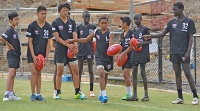Multicultural Growth To Boost Australian Football
- Monday, April 17 2017 @ 12:05 am ACST
- Contributed by: Wesley Hull
- Views: 2,736


If there was one thing that was learned last week being witness to the 2017 AFL National Male Kickstart & All Nations Championships it was that the multicultural game is growing in numbers and standards. The future of the game’s growth both in Australia most likely overseas could get a huge boost as the multicultural carnivals drive growth.
This claim is highlighted rather dramatically by the growth since the 2015 carnival in Cairns. At that event the team numbers were smaller, as was the playing field. Fifteen players a side played on a makeshift mini-field within the larger Cazaly’s Stadium. It looked very much like the set up for junior matches.
Fast forward to 2017 and the All-Nations competition (made from teams where player’s ancestry of themselves or their parents was having been born overseas) and teams played 16 per side, no wings and on a full sized oval. Not only that, but the standards of play were a far cry from the tournament in Cairns.
The players in the All Nations teams were eligible for selection in the World team – the best players from the All Nations championship. Whilst the title “World” team could be argued as the wrong choice of title, the players couldn’t care less. They were proud to rise to the challenge of being selected in a national team made up of other kids from a variety of cultural backgrounds. The name didn’t matter to them…pride and desire did.
A look at the cultural origins of each player at the tournament gives a staggering 50 or so backgrounds. Whilst there will be a couple missed that were not listed in official programs, the breakdown looks like:
Australia: Australia, Aboriginal, Torres Strait Islander
Asia: India, Philippines, Japan, Singapore, Thailand, Pakistan, Indonesia, Burma/Myanmar, Sri Lanka, Malaysia, Laos, China, Cambodia, Korea, Vietnam, East Timor
Europe: England, Ireland, Netherlands, Scotland, Poland, Italy, Serbia, Austria, Germany, Greece, Russia, Spain, Portugal,
Americas: USA, Chile, Brazil, Canada
Africa/Middle East: Liberia, Lebanon, Zimbabwe, Sudan, Congo, Kenya, Ethiopia, Nigeria, Mauritius
Oceania: New Zealand, Papua New Guinea, Tonga, Samoa, Fiji
With so many different cultural backgrounds, it stands to reason that there will be many of these young men who will take their experience in the game back to their cultural communities. If this leads to an increased interest in that community, then growth will occur (and has occurred), with many African communities embracing the game on the back of successful graduates going on to play at the highest level (Aliir Aliir, Majak Daw, Reuben William, Mabior Chol of the present lists).
When enough success follows the initial interest within Australian communities, it doesn’t take long for that interest to gradually spread to communities across the world – the International Cups are a good example of that extension where overseas cultural communities have got behind national teams, some of which contain graduates from elite junior tournaments.
But some may argue that there is a disconnect between a young Australian lad and their generational cultural background – the idea that culture means less and less over generations. Of the boys interviewed over the recent All nations event, unerringly these boys were not only proud of their cultural heritage, but were conscious of working within their own communities to grow the game further.
The connection between “international” and “multicultural” Australian football is small and in some ways yet to be fully proven. But on the evidence present at the recent championships the symbiotic relationship between the two is drawing closer and closer – and that is something wonderful for the game.


 RSS news
RSS news Twitter
Twitter Facebook
Facebook